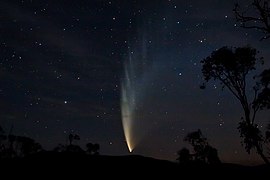 | |
| Discovery | |
|---|---|
| Discovery date | 7 August 2006 |
| Designations | |
| C/2006 P1, Comet McNaught, Great Comet of 2007 | |
| Orbital characteristics | |
| Epoch | 2454113.2961 (20 January 2007) |
| Observation arc | 338 days |
| Number of observations | 331 |
| Orbit type | Oort cloud |
| Aphelion | ~67,000 AU (inbound)[1] ~4,100 AU (outbound)[a] |
| Perihelion | 0.1707 AU (25,540,000 km) |
| Semi-major axis | ~33,000 AU (inbound) ~2,000 AU (outbound)[a] |
| Eccentricity | 1.000019[2] (hyperbolic trajectory) |
| Orbital period | ~6 million years (inbound)[1] ~92,600 yr (outbound)[3][a] |
| Max. orbital speed | 101.9 km/s (228,000 mph)[4] |
| Inclination | 77.82768004° |
| Last perihelion | 12 January 2007[2] |
| Jupiter MOID | 0.32 AU |
Comet McNaught, also known as the Great Comet of 2007 and given the designation C/2006 P1, is a non-periodic comet discovered on 7 August 2006 by British-Australian astronomer Robert H. McNaught using the Uppsala Southern Schmidt Telescope.[5] It was the brightest comet in over 40 years, and was easily visible to the naked eye for observers in the Southern Hemisphere in January and February 2007.
With an estimated peak magnitude of −5.5, the comet was the second-brightest since 1935.[6] Around perihelion on 12 January, it was visible worldwide in broad daylight. Its tail measured an estimated 35 degrees in length at its peak.[7]
The brightness of C/2006 P1 near perihelion was enhanced by forward scattering.[8]
- ^ a b Cite error: The named reference
barycenterwas invoked but never defined (see the help page). - ^ a b "JPL Small-Body Database Browser: C/2006 P1 (McNaught)" (2007-07-11 last obs.). Retrieved 17 December 2009.
- ^ "Comet C/2006 P1 (McNaught) – facts and figures". Perth Observatory in Australia. 22 January 2007. Archived from the original on 18 February 2011. Retrieved 1 February 2011.
- ^ Cite error: The named reference
perihelion-kmswas invoked but never defined (see the help page). - ^ "Report on the comet discovery and progress from Robert McNaught's homepage". Archived from the original on 19 January 2007. Retrieved 17 January 2007.
- ^ "Brightest comets seen since 1935". Harvard. Archived from the original on 28 December 2011. Retrieved 12 January 2007.
- ^ "Kronk's Cometography – C/2006 P1". Retrieved 21 January 2010.
- ^ Marcus, Joseph N. (October 2007). "Forward-Scattering Enhancement of Comet Brightness. II. The Light Curve of C/2006 P1" (PDF). International Comet Quarterly. pp. 119–130.